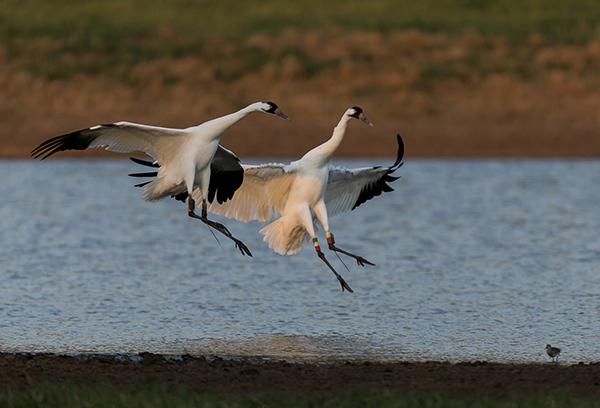
The Whooping Crane pair (nos. 11-09 and 15-09) return to their evening roost site near
Tallahassee, Florida. Photo by Karen Willes
By Dr. George Archibald, ICF Co-founder & Senior Conservationist
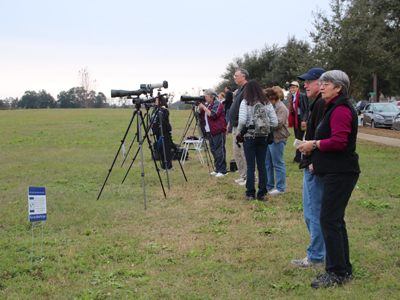 Late Sunday afternoon of January 5, 2014, while Baraboo was in the grips of an extremely cold winter, I had the privilege of meeting my friends and conservationists, Colin and Anne Phipps, near Tallahassee, Florida. We were waiting, in company with about 40 others, for a pair of Whooping Cranes to land beside a large pond in a cow pasture near balmy Tallahassee (right). These cranes were hatched at the Patuxent Wildlife Research Center in Maryland in 2009, reared by colleagues of Operation Migration (OM) at the Necedah National Wildlife Refuge in Wisconsin that summer, then led by OM pilots and their ultra-light aircraft to St. Marks National Wildlife Refuge, approximately 25 miles south of Tallahassee in northern Florida. In the spring of 2010 the cranes migrated back to Wisconsin, and that autumn spent the winter feeding on agriculture fields and in wetlands near Tallahassee and roosting at night in the aforementioned cow pasture. This pattern has been repeated the past three winters. In both 2012 and 2013, at the age of three and four years, they nested at Necedah, but abandoned their nests, apparently in response to the hatch of black flies in late April. Their eggs were collected, hatched in incubators, and the young cranes were used in release experiments at sites in eastern Wisconsin where there are fewer black flies.
Late Sunday afternoon of January 5, 2014, while Baraboo was in the grips of an extremely cold winter, I had the privilege of meeting my friends and conservationists, Colin and Anne Phipps, near Tallahassee, Florida. We were waiting, in company with about 40 others, for a pair of Whooping Cranes to land beside a large pond in a cow pasture near balmy Tallahassee (right). These cranes were hatched at the Patuxent Wildlife Research Center in Maryland in 2009, reared by colleagues of Operation Migration (OM) at the Necedah National Wildlife Refuge in Wisconsin that summer, then led by OM pilots and their ultra-light aircraft to St. Marks National Wildlife Refuge, approximately 25 miles south of Tallahassee in northern Florida. In the spring of 2010 the cranes migrated back to Wisconsin, and that autumn spent the winter feeding on agriculture fields and in wetlands near Tallahassee and roosting at night in the aforementioned cow pasture. This pattern has been repeated the past three winters. In both 2012 and 2013, at the age of three and four years, they nested at Necedah, but abandoned their nests, apparently in response to the hatch of black flies in late April. Their eggs were collected, hatched in incubators, and the young cranes were used in release experiments at sites in eastern Wisconsin where there are fewer black flies.
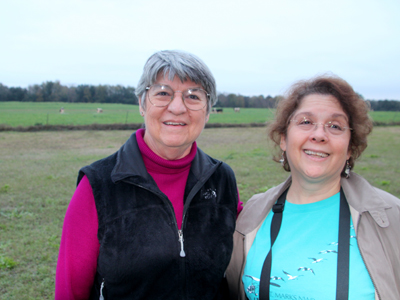
Karen Willes is a church musician in Tallahassee. In 2005, she took up bird photography and since 2012 has been observing, protecting and photographing the cranes in the pasture. Through her knowledge, enthusiasm, and presence with tripod and camera beside the road, she has shared the cranes’ story with passersby – many of whom have joined Karen in watching these magnificent birds at the pond and their dramatic flights away in the early morning and their return at dusk. On the afternoon of my visit, it was a pleasure to meet these “craniacs”, to hear their stories, and to share a few of mine as we waited for more than an hour for the royals to arrive.
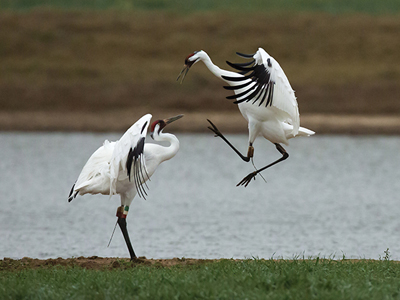
The pond is shallow and covers about half an acre surrounded by well-grazed pasture populated by a herd of Holsteins. As we waited, cows were coming and going to drink at the pond. A few greater yellowlegs, sanderlings, and killdeer (all shorebirds) searched for food in the mud that separated the water from the grass. In small flocks, about 40 Canada geese arrived as the light was fading. Finally, at 6:01 pm, with light almost gone, someone shouted, ”They’re coming!” Over the treetops from the south the two huge cranes arrived, and amidst the clicking of many cameras, they circled the pond three times and landed on the side nearest their admirers. They drank, avoided a cow that approached, and then started to preen as darkness descended.
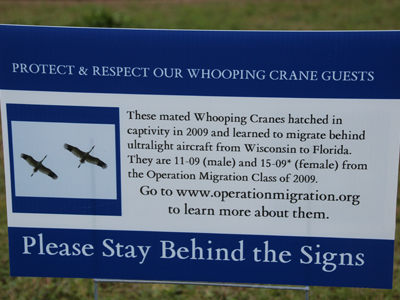 Concerned that close proximity to humans would tame the cranes and make them more vulnerable to humans in other areas, with permission from the land’s development company, informative signs have been posted on the grass near the road, telling visitors about the cranes, and asking them not to approach the pond (right). A local resident told me of a photographer who had approached the cattle fence half-way from the road to the pond to get closer to the cranes. She explained her concerns, and the man kindly moved back near the road.
Concerned that close proximity to humans would tame the cranes and make them more vulnerable to humans in other areas, with permission from the land’s development company, informative signs have been posted on the grass near the road, telling visitors about the cranes, and asking them not to approach the pond (right). A local resident told me of a photographer who had approached the cattle fence half-way from the road to the pond to get closer to the cranes. She explained her concerns, and the man kindly moved back near the road.
The company that owns the housing development across the street also owns the pasture and leases the latter to a farmer. However, when the houses in the first phase of the development are all sold, there are concerns that the pasture will be developed as Phase Two. Karen and her friends are now investigating possibilities for conserving that land for both cows and cranes.
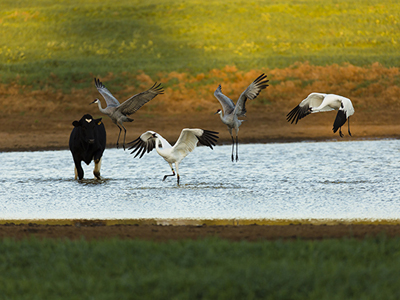
Since 2001 captive-reared Whooping Cranes have been led by OM to Florida, and since 2005 others raised by ICF have been released with the older Whooping Cranes in Wisconsin, and have also migrated to the Southeast. The population now includes over 100 birds, and they winter near wetlands from southern Indiana to northern Florida, and as far east at South Carolina. The common denominators in the selections of wintering sites are agricultural fields and shallow wetlands for feeding, wetlands with commanding views of surrounding landscapes for roosting at night, and lack of disturbance. Unfortunately, more and more Whooping Cranes over the past few years are known to have been shot by vandals. Consequently, for cranes feeding and/or roosting in areas where they are readily seen by humans, volunteers like Karen Willes and her colleagues in Tallahassee can be vital in helping to assure the safety of the cranes, and helping to guarantee that humans keep their distance.
I wish to most sincerely thank Karen and her friends for their contribution to the conservation of the Great White Birds.
